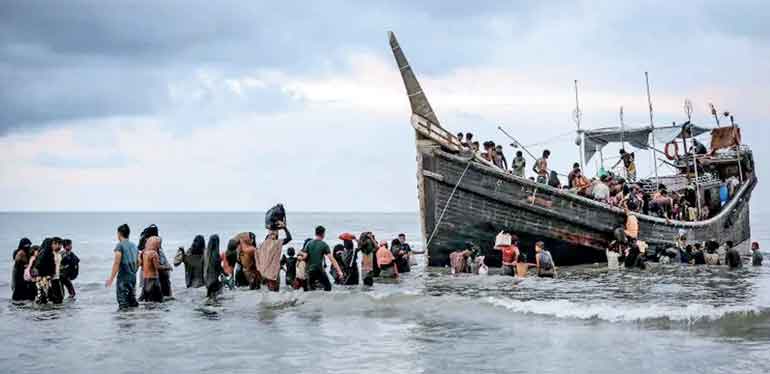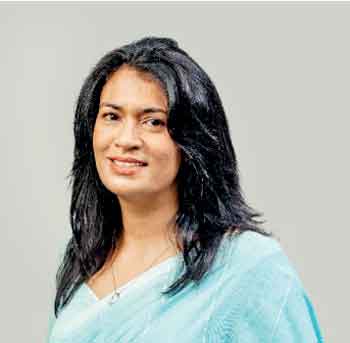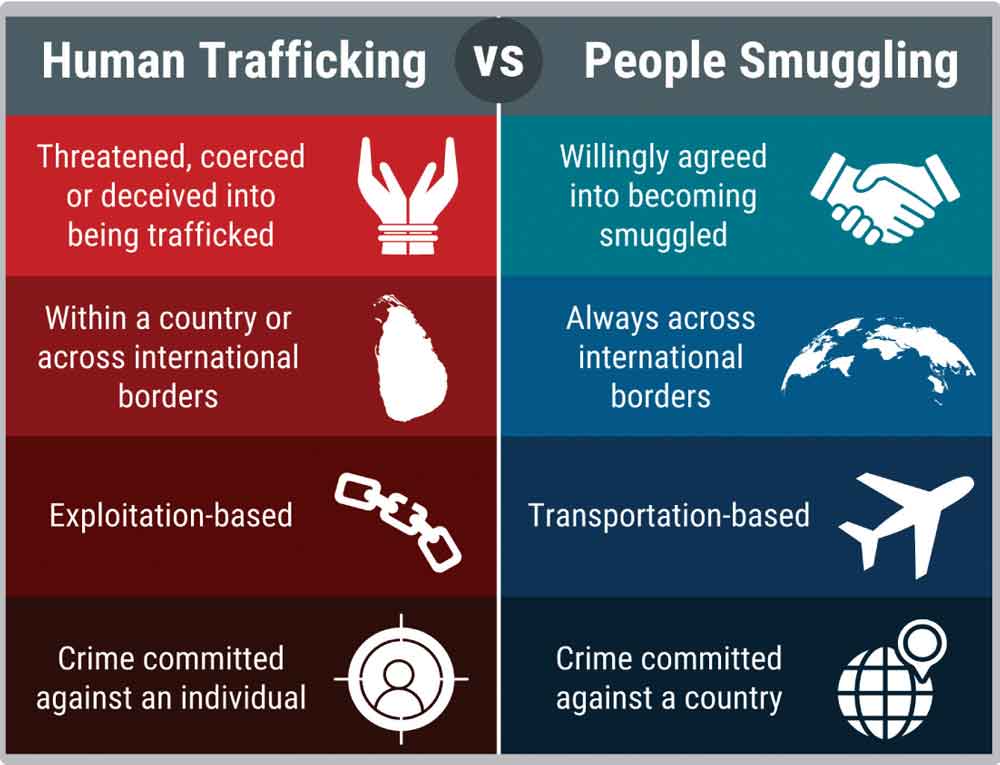Thursday Nov 06, 2025
Thursday Nov 06, 2025
Saturday, 25 January 2025 00:02 - - {{hitsCtrl.values.hits}}

Given the informal nature of payments for the service delivery of people smuggling, there is a possibility that these Rohingya people were
trafficked into Sri Lanka – Pic courtesy: Al Jazeera
 By Bilesha Weeraratne, PhD
By Bilesha Weeraratne, PhD
While the bedrocks of migration in Sri Lanka – foreign employment and remittances – are settling, other aspects are unsettling in 2025. The year 2024 closed with estimates of over 311,000 departures for foreign employment and over $ 6.5 billion in remittances. In December 2024, 115 Rohingya people, including 78 adults and 25 children, were rescued while traveling on a multi-day trawler off the coast of Mullaitivu. The group was seeking asylum in Sri Lanka, and 12 men were identified as having facilitated the voyage. Similarly, three batches of Sri Lankan migrants who were trafficked for forced criminal activities in cyber scamming compounds in East Asia were repatriated in 2024. Many “were coerced into various cyber scamming activities under the pretext of legitimate job offers in the IT sector and other customer service roles”.
 Illegal immigrants vs. Refugees
Illegal immigrants vs. Refugees
The payment refugees make for passage blurs the line between those seeking asylum and those attempting to enter a country illegally. Reports raise concerns that the Rohingya people were “illegal immigrants of an organised human trafficking scandal” and that intelligence sources warn the impending arrival of another approximately 100,000 through similar means in the near future. Moreover, there are concerns about the involvement of local counterparts in the arrival of such Rohingya people. The Sri Lankan Government maintains the position that “if they proved to be refugees, they would be treated and provided with all necessary humanitarian assistance under the international law related to refugees”. Yet as per ongoing investigations and intelligence sources, “it clearly shows that it is a human trafficking scandal and that they are not refugees”.
Link between refugees, human trafficking and people smuggling
Seeking asylum as refugees, smuggling of people and human trafficking are highly interconnected phenomenon. A refugee is one who is forced to leave their country to escape persecution, war, violence, or natural disaster due to a “well-founded fear of persecution for reasons of race, religion, nationality, political opinion or membership in a particular social group”. In the absence of formal pathways to leave the oppressing country or enter another, refugees often pay smugglers to travel across countries. Therefore, people smuggling consists of assisting migrants to enter or stay in a country illegally, for financial or material gain. Smugglers make a profit out of migrants’ need and/or desire to enter a country and the lack of legal documents to do so. Those who consent to people smuggling often end up being trafficked during the process. Human trafficking is when three critical aspects are fulfilled. They are,
1.an act (recruitment, transportation, transfer, harbouring, or receipt of people);
2.by a specific means (threats or use of force, deception, fraud, abuse of power, or abusing someone’s vulnerable condition); and
3.for exploitation (sexual exploitation, forced labour, slavery or organ removal for example).
Costly passage
The Rohingya people who have reached Sri Lanka seeking asylum have paid hefty sums for this risky – yet compelling passage, to avoid alleged harsh experiences in Myanmar. Reports suggest that these Rohingya people paid as much as “5 million in their currencies” to be smuggled into Sri Lanka. Given the informal nature of payments for the service delivery of people smuggling, there is a possibility that these Rohingya people were trafficked into Sri Lanka. Ironically, while Rohingya people are fleeing Myanmar and arriving in Sri Lanka seeking asylum, a growing number of Sri Lankan migrants are being trafficked into the camps of online crime syndicates operating in Myanmar and other East Asian countries.
Policy options
As such, in 2025, the new Government would be challenged beyond the comfort zone of promoting labour migration and receiving remittances and would need to gear up to face emerging challenges of trafficking, smuggling, refugees, and asylum seekers. In this context, to steer Government position and policy directions, it would be important to have a clear understanding of the distinction between trafficking and smuggling, as well as the interlinkages between these two and refugees and asylum seekers.
Moreover, while people smuggling and human trafficking can ideally be addressed within the penal code of Sri Lanka, handling refugees and asylum seekers is more nuanced owing to the need to balance humanitarian, sovereignty and border control, as well as socio-economic aspects. Despite not having ratified the 1951 Convention on the Status of Refugees and its 1967 Protocol, Sri Lanka provides space for refugees and asylum seekers to submit their claims to the UNHCR in Sri Lanka and to remain until a durable solution is achieved in each specific case. One of the immediate economic concerns regarding refugees is the cost of hosting them in temporary settlements or camps while their asylum claims are processed. This becomes a significant financial burden for a cash-strapped country like Sri Lanka. Additionally, it involves the fear of attracting further inflows of refugees.
In the long term, refugees will face challenges related to their integration, not limited to issues such as access to the labour market and demand for social infrastructure like healthcare and housing. Depending on the circumstances, countries such as Germany, Sweden and France to name a few, offer temporary protection to individuals from specific countries such as Syria and Ukraine during emergencies while restricting long-term settlement. Some countries have discouraged refugees by tightening border control measures, where the United States, for instance, has erected giant border walls and the previous Trump administration adopted a zero tolerance policy towards illegal border crossings. Similarly, Australia actively turns back boats carrying asylum seekers.
Among a plethora of options, a more viable policy option for Sri Lanka would be to increase stricter border control measures to deter future inflows of refugees. Another is to discourage future arrivals by adopting awareness campaigns targeting Rohingya people to shape their public perception regarding immigration to Sri Lanka and highlight Sri Lanka’s challenges in accepting refugees. These efforts to increase border control and awareness campaigns could emulate the highly successful Operation Sovereign Borders and Zero Chance campaign adopted by Australia, which discouraged the outflow of Sri Lankans to Australia by boat. Perhaps Sri Lanka could seek the cooperation of other countries facing similar challenges, including the Australian Zero Chance campaign, to better understand the policy options to cover illegal migration between Myanmar and Sri Lanka.

(The writer is a Research Fellow and Head of Migration and Urbanisation Research at IPS. Prior to re-joining IPS in 2014, she was a Postdoctoral Research Associate at Princeton University, New Jersey, USA. Her research interests include internal and international migration, climate mobility, urbanisation, the economics of education, labour economics, economic development, econometrics and economic modelling. She holds an MA in Economics from Rutgers University, USA and an MPhil and PhD in Economics from the City University of New York, USA.)